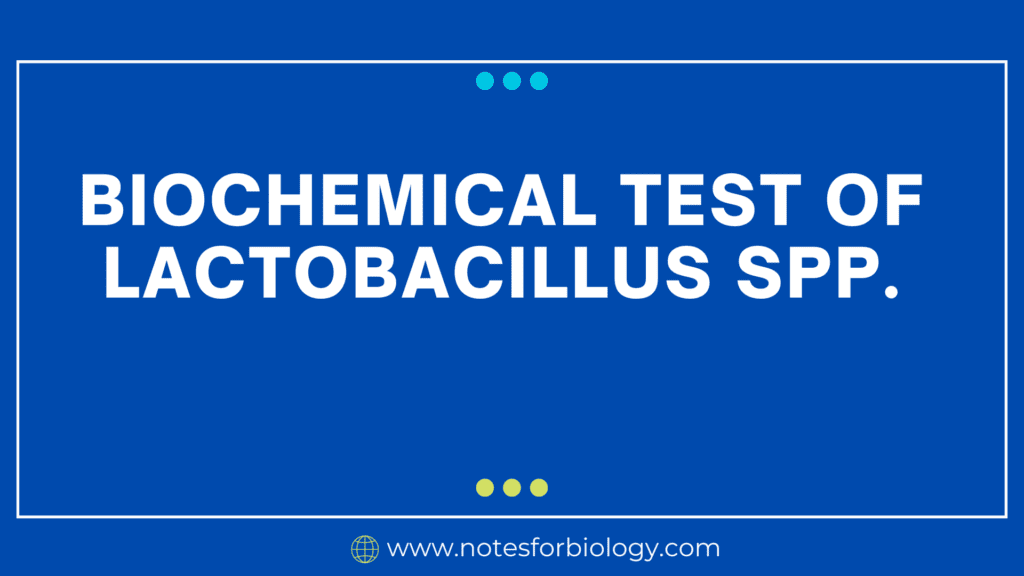what is Lactobacillus spp.?

The term “Lactobacillus spp.” describes a broad category of bacteria that are members of the Lactobacillus genus. Numerous habitats, including the human stomach, mouth, and vagina, are naturally home to these bacteria. Since they are usually regarded as helpful bacteria, they are good for human health.

Table of Contents
Lactobacillus species
A collection of microorganisms belonging to the genus Lactobacillus is referred to as Lactobacillus spp. These rod-shaped, gram-positive bacteria are well-known for their capacity to produce lactic acid from lactose and other carbohydrates. Because of the fermentation process, which lowers the pH of their surroundings and prevents the growth of numerous dangerous bacteria, Lactobacillus species are crucial for a variety of uses.
Biochemical Test of Lactobacillus spp.
With over 200 species known, Lactobacillus spp. constitute a varied group of bacteria. Even though some of their traits are similar, phenotypic and genotypic testing are frequently needed to distinguish between different species. To identify Lactobacillus species, the following biochemical assays are frequently used:
fermentation of carbohydrates
Almost all Lactobacillus species convert glucose to lactic acid during fermentation.
Other Sugars: The capacity to ferment other sugars, such as lactose, galactose, fructose, mannose, sucrose, maltose, and raffinose, varies among species. One important indicator may be this pattern of uneven fermentation.
Method: The API 50 CHL system or phenol red broth are frequently used to measure the fermentation of carbohydrates. Changes in colour in the broth or API strips signify the fermentation-induced generation of acid.
Test for Catalase
As a result, Lactobacillus species lack the catalase enzyme, making them catalase-negative.
Method: A bacterial colony is given a drop of hydrogen peroxide. A bad outcome is indicated by the lack of bubbling.
The Gramme Stain
As a result, lactobacillus species are purple under a microscope and are Gram-positive.
Method: To distinguish between bacteria based on the composition of their cell walls, a standard Gramme staining technique is employed.
Conditions for Growth
Oxygen: Because the majority of Lactobacillus species are microaerophilic, they favor low oxygen concentrations. Although they may grow in anaerobic environments, they prefer oxygen-rich environments.
Temperature: Although ideal growing temperatures vary, they typically fall between 30 and 37°C.
pH: Lactobacillus species are acidophiles, which means that they can survive and even grow in settings with an acidic pH (4.5–6.5).
Additional Biochemical Test
Nitrate reduction, Nitrate can be converted to nitrite by some Lactobacillus species.

Hydrolysis of esculin The hydrolysis of esculin by certain Lactobacillus species results in the medium becoming brown.
Gelatin hydrolysis The medium becomes liquefied when certain Lactobacillus species hydrolyze gelatin.
Molecular Techniques
The gold standard for bacterial identification is 16S rRNA sequencing. In order to identify species, the 16S rRNA gene sequence is compared to a database.
MALDI-TOF MS Using mass spectrometry, this technique detects bacteria by analysing their protein patterns.
Important of Biochemical Test
Identification and Characterization
Based on their physiological traits and metabolic pathways, Lactobacillus species can be distinguished from one another using biochemical tests.
Selection of Strain
Particular Probiotics and food fermentation are just two uses for lactobacillus strains. The best strains are chosen with the use of biochemical testing.
Quality Control
Biochemical tests play a crucial role in industrial applications for quality control and assuring the uniformity of Lactobacillus cultures.
Important Note
Usually, a single biochemical test is insufficient to provide a definitive diagnosis. Combining results from several tests and taking the organism’s overall profile into account is essential. Molecular techniques are becoming more and more crucial for accurately identifying Lactobacillus species.
Frequently Asked Questions(FAQ)
What is Lactobacillus spp.?
The term “Lactobacillus spp.” describes a broad category of bacteria that are members of the Lactobacillus genus. Numerous habitats, including the human stomach, mouth, and vagina, are naturally home to these bacteria. Since they are usually regarded as helpful bacteria, they are good for human health.
What is the importance of Biochemical Test of Lactobacillus spp.?
The importance of biochemical Test of Lactobacillus spp. Biochemical tests play a crucial role in industrial applications for quality control and assuring the uniformity of Lactobacillus cultures., Based on their physiological traits and metabolic pathways, Lactobacillus species can be distinguished from one another using biochemical tests.
What are its additional Biochemical Test?
Its additional Biochemical Test are
Nitrate reduction
Hydrolysis of esculin
Gelatin hydrolysis
Related Articles


